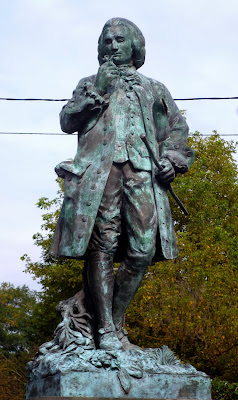'Jean-Jacques ROUSSEAU
Habitant de Montmorency 1756–1762'
The avenue Émile roundabout, Montmorency. This is the third statue of Jean-Jacques Rousseau (1712–78) here: the first was in bronze and by Louis Carrier-Belleuse in 1907, but was melted down during the war; the second was made in stone by Hélène Gustala, but was destroyed by a traffic accident in 1994; the present statue is a larger-scale reproduction of one made in 1860 by Albert Carrier-Belleuse, Louis's father.
Rousseau had set up household with Thérèse Levasseur, a linen maid who gave birth to five of their children, although they were all sent away as orphans. In April 1756 he escaped the 'ville de fumeé, de bruit et de boue' ('town of smoke, noise and mud') that he believed Paris had become, to live in Montmorency to the north of Paris. Originally they stayed in the 'Hermitage', lent to him by Mme d'Épernay, but moved to 'le petit Mont-Louis' the following year after an argument with his host.
This is now the Musée Jean-Jacques Rousseau, the area on the left of the photo (partly concealed by foliage) being the original part where Rousseau and Levasseur lived.
'Dans cette maison
J. J. ROUSSEAU
a vécu de 1757 – 1762'
Just before the entrance to Rousseau's former living quarters is a replica, by Jean Baptiste Stouf, of a bust by Jean-Antoine Houdon.
A reconstruction of the kitchen.
A reconstruction of Thérèse Levasseur's bedroom. Scarcely visible on the dressing table is a candle snuffer, which I learned is called a mouchette in French.
And the stairs to the other floor.
And a reconstruction of Rousseau's bedroom, although of course not his original bed.
The only definite original object in the tiny house is the fireplace, which came from the donjon (see further down).
Rousseau worked on his major publications in Montmorency: Julie ou la Nouvelle Heloise, La Lettre à d'Alembert sur les spectacles, Du contrat social, and Émile ou de l'Éducation, of which the last book – Profession de foi du vicaire savoyard – caused a storm with religious bodies, was condemned by the parlement de Paris, and forced him to flee Montmorency for Switzerland in June 1762.
The clock here is most appropriate because it was made in 1712 – the year of Rousseau's birth, in Geneva – the place of his birth.
The donjon, where Rousseau used to write.
In the 'cabernet de verdure' as Rousseau referred to it is this table.
The inscription here is by Gabriel Brizard (1744–1793), a tremendous admirer of the philosophes, and among other books he published the complete works of Rousseau. Brizard is full of praise for the great man, and the words refer to this stone as 'the altar of genius'.
'C'EST ICI QU'UN GRAND HOMME A PASSÉ SES BEAUX JOURS.
VINGT CHEF-D'ŒUVRES DIVERS EN ONT MARQUÉ LE COURS.
C'EST ICI QUE SONT NÉS ET SAINT-PRIEUX ET JULIE
ET CETTE SIMPLE PIERRE EST L'AUTEL DU GÉNIE'
27 Mars 1787
G. BRIZARD'
The garden at the back. A great day, and I'm very grateful to our enthusiastic guide, especially for her forbearance when I was translating things for Penny.



















No comments:
Post a Comment